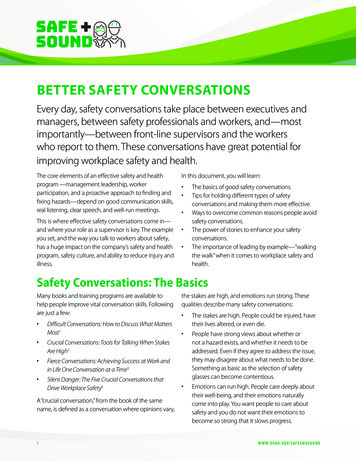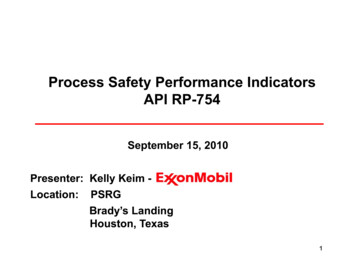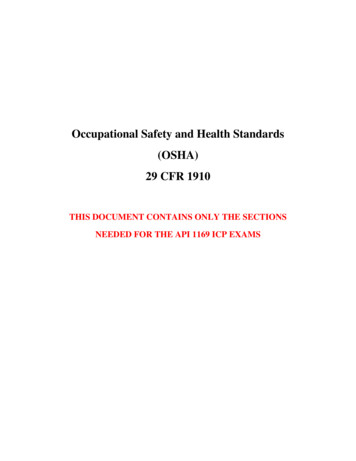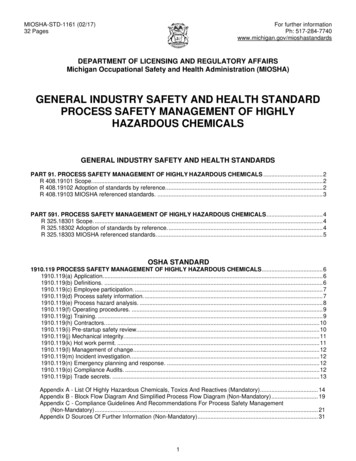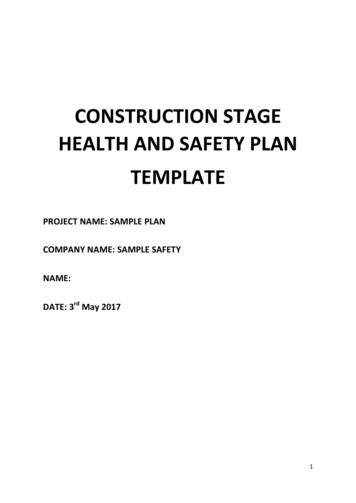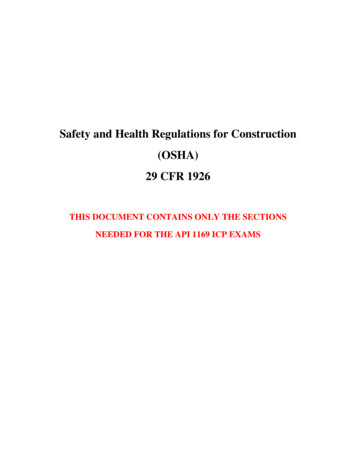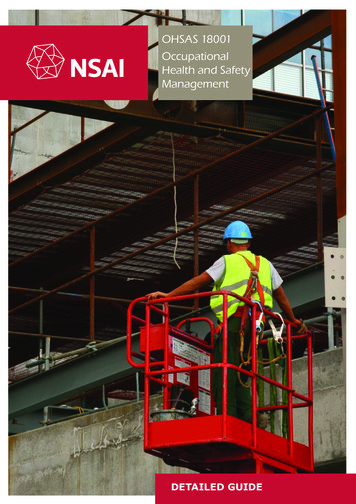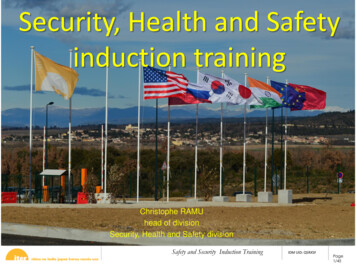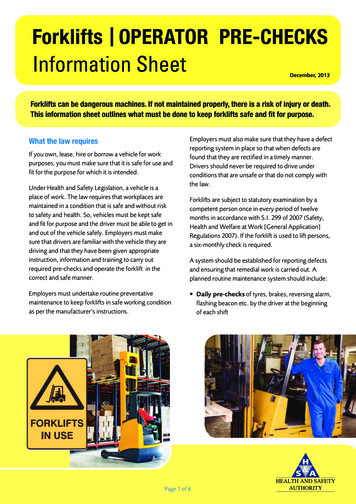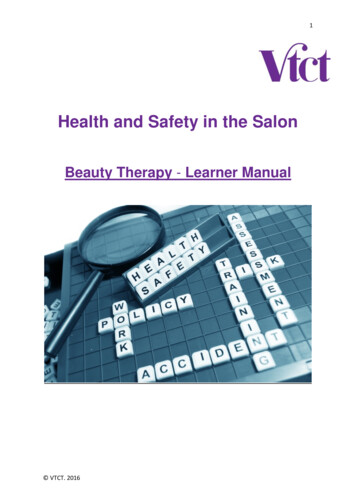
Transcription
1Health and Safety in the SalonBeauty Therapy - Learner Manual VTCT. 2016
2Health and Safety in the SalonAimThe aim of this manual is to develop understanding of the principles of health and safety atwork within a salon, barbershop or spa. It will introduce the overarching legislation andexplore the measures designed to protect the health and safety of people in the workplace,including staff, visitors and members of the public. It will also develop knowledge of how torecognize hazards and their associated risks along with the understanding of skills requiredto manage a safe and hygienic work environment that meets with the necessary regulationsand legislation requirements.Learning outcomesBy the end of this unit the learner will: Know the principles of health and safety Understand how to maintain health, safety, hygiene and security practices Understand how to follow emergency procedures VTCT. 2016
3TerminologyHealthA state of wellbeingSafetyThe absence of risksWorkplaceAny area or building where people workHealth and safetypolicyA document outlining an employer’s policy and commitmentto health and safetyHealth and SafetyExecutive (HSE)The body that regulates health and safety and enforcesauthorityAccidentAn unplanned and uncontrolled event with the potential tocause injuryHazardSomething that has the potential to cause harmRiskThe likelihood that a hazard will cause harmPersonal protectiveequipment (PPE)Specialist equipment or clothing to protect from harmagainst safety hazards, e.g. gloves, goggles, protectiveapronWelfareThe provision of facilities and any other measures to ensurea person’s wellbeingAppointed personA person with specific duties, for example relating to first aidbut not necessarily a person who is trained in first aidWork related stressFeeling anxious, unwanted pressure that can cause harm tothe mind and body and has strong links to absences fromwork VTCT. 2016
4Section 1: The principles of health and safetyThe importance of health and safetyHealth and safety is important to keep people and safe and prevent them from harm!The main purpose of the various laws and legislation is to ensure health, safety and welfareof people is a priority! These laws apply to all working environments, including hair andbeauty salons and to self-employed and mobile hairdressers and beauty therapists.Health and safety law applies to everyone in the workplace – employers, staff, customersand visitors or guests. Employers have responsibility to provide and maintain a safe working environment andwelfare facilities. They are also responsible for developing policies and standard ornormal operating procedures to guide safe practice. Employers must provide safe working systems Staff need to follow these procedures in all their daily activities. They need to beinducted to health and safety requirements and receive other specialist trainingrequired for their work role, e.g. risk assessment, first aid, manual handling, safe use ofchemicals. VTCT. 2016
5 Customers, visitors and guests need to be informed of appropriate rules andbehaviours to ensure they also take responsibility for their safety, e.g. followinginstructions from signs provided, such as not walking across a wet floor where a signhas been displayed.Everyone has responsibility for maintaining health and safety.The main factors that influence health and safety in a hair and or beauty salon include: Environmental factors – conditions in the workplace and working area, for examplethe working temperature, ventilation and noise Occupational factors – the potential risk of certain illnesses due to the services ortreatments being offered, for example asthma from exposure to certain hairdressing orbeauty products Human factors – how people can contribute to accidents due to inappropriate or poorbehaviour, carelessness, error or haste VTCT. 2016
6The legal and regulatory requirements for health and safetyThere are numerous guiding legislations for health and safety. The Health and Safety at Work Act (1974) The Health and Safety at Work Act (1974) was the main piece of legislation offeringdirectives to maintain health and safety in England, Scotland and Wales. The Act wasexpanded, and in 1999, was replaced by the Management of Health and Safety atWork Regulations. 1999 The Health and Safety at Work Order 1978 (Northern Ireland) was the main piece oflegislation for Northern Ireland. The Act was expanded, and in 2000, was supersededby the Management of Health and Safety at Work Regulations 2000 (Northern Ireland)Despite these developments, the main guiding principles of both the Healthand Safety at Work Act (1974) and the Health and Safety at Work Order 1978(Northern Ireland) continueThe main guiding principles include: The health, safety and welfare of all people should be maintained at all times and allorganisations should operate within policy guidelines. Hazardous chemicals or substances should be handled and stored securely and risk ofemission should be controlled. People should be protected against any risks that may occur as a result of activities inthe workplace. The work place should provide clean and hygienic facilities, including the availability ofdrinking water, changing areas and toilets, first aid rooms in larger organisations Appropriate equipment should be provided for use and adequately maintained. The appointment of qualified staff to provide supervision and instruction (asappropriate) and the provision of additional training, as required, e.g. first aid andhealth and safety. Adequate insurance to cover accidents, e.g. employer and public liability The provision of reporting and recording mechanisms, e.g. accident books Regular review and evaluation of all healthy and safety policies and procedures toensure they are current, valid and reliable.Employers and employees have direct responsibilities for health and safetyand a ‘duty of care’ to take reasonable and practicable steps to ensure thatpeople are kept safe and free from harm. VTCT. 2016
7Employers mustEmployees must Provide and maintain safe workingenvironment. Act responsibly and not endanger selfor others by an individual’s actions. Provide adequate welfare facilities.Provide safe systems of work. Co-operate with an employer to fulfilduties. Provide information, training andsupervision. Not misuse anything provided in theinterests of health and safety. Ensure the safe handling, storage andmovement of goods and materials.Provide and maintain safe equipment. Report all accidents, incidents andunsafe conditions of practice.For example:For example: Mandatory attendance at trainingsessions. Ensuring they present a professionalimage. Ensuring their conduct is professionaland aligns with salon guidance. Reporting verbally or in writing tomanager, supervisor or salon owner anyaccidents or incidents, however minor,that may occur Providing a training session specificallydealing with the salon’s policies andreporting on sickness and generalwelfare, handling and storage ofequipmentProviding training sessions forhairdressing and/or beauty therapy todevelop skills and product knowledge Providing a salon uniform. Providing training on professionalconduct and how to greet clients andanswer telephone callsAll organisations employing more than five people are requiredto display a health and safety poster.Management of Health and Safety at Work Regulations. 1999 and Managementof Health and Safety at Work Regulations 2000 (Northern Ireland)The 1999/2000 regulations emphasised the importance of risk assessment to ensure safety.All staff, whether employed or self-employed have a responsibility to assess their workingareas and assess any risk to themselves, their work colleagues and members of the public.The Health and Safety Executive (HSE) provide five simple steps for assessing andmanaging risk1. Identify the hazards (anything that may cause harm)2. Determine who may be harmed3. Evaluate the level of risk (likelihood and severity) and decide on precautions needed4. Record all findings5. Review and update regularlyFurther information on risk assessment is available from the tm. VTCT. 2016
8Reporting of Injuries, Diseases and Dangerous Occurrences Regulations 1995(RIDDOR)The RIDDOR regulations require that ALL injuries, diseases and dangerous events thathappen in the workplace are recorded using the appropriate recording document andreported to the Health and Safety Executive (HSE).Work-related illnesses may include dermatitis or occupational asthmafrom the use of specific hair or beauty products.The HSE are responsible for enforcing safety regulations and investigate reported incidentsand provide advice to organisations. Enforcement of regulations may include prosecution, ifappropriate steps have not been taken.Employees must ensure that they have notified the employer of anypotential work-related illness, injury or dangerous occurrence that occurs withinthe salon in order that the employer can fulfil their reporting obligationsControl of Substances Hazardous to Health Regulations 2002 (COSHH)The COSHH regulations require that appropriate assessment and precaution is taken toprotect against harm from hazardous substances.In a salon environment this may include: Chemicals, such as those used for cleaning and products used for hair colouring etc. Biological agents, such as bacteria in spa areas (Jacuzzis) or in laundry facilities (whensterilising equipment) Naturally occurring substances, such as dust or mould in damper, humid areas e.g.Jacuzzi, steam rooms or even the salon itselfIt would also include substances produced during work activities, such as,fumes from mixing of chemicals or electrical filing of nails VTCT. 2016
9Some general guidelines are: All hazardous substances should be identified and the risk they present should bestratified. Precaution should be taken to minimise the risk, which may include the provision ofprotective clothing, e.g. use of gloves or face masks to prevent contact with the skin orinhalation. Exposure should be minimised. If the activity the chemical is used for is not essential,than it should be stopped; alternatively, if the activity is essential (e.g. cleaning), thenthe safer types of chemical or forms of the chemical should be used. Controls should be put in place. Staff should be trained to use chemicals, e.g. haircolouring and time spent in the environment with chemicals should be reduced. Theyshould also be informed of the risks of being exposed to specific chemicals andinvolved in risk assessment. All chemicals should be stored safely and labelled. Anychemicals that offer greater danger should be kept in limited access areas. Review and monitor all systems and procedures.Employers must Assess the risk to health from hazardous products and decide what precautions arerequired. Introduce appropriate measures to control exposure to hazardous products. Ensure employees follow the control measures and safety precautions and useprotective equipment when appropriate. Inform and instruct employees about the risks and precautions and train accordinglyin dealing with, storing and disposing of hazardous products, e.g. aerosol hairspraysto be kept away from naked flames and heat sources. Attend appropriate training. Follow information and instruction on both hazardous and potentially hazardouschemicals used in the salon. E.g. the correct storage of hydrogen peroxide which isclassed as hazardousPersonal Protective Equipment 2002 (PPE)PPE regulations require the provision of appropriate protective clothing and equipment.In a salon environment, this may include the provision of: Trolleys to move products and minimise spillage Bowls for mixing products Gloves and masks when handling colorants and chemicals, e.g. hydrogen peroxide Plastic gowns and capes to protect the client Training for staff on how to use of equipmentAny equipment used should be of an appropriate fit, be well maintained and stored correctly.NB: Appropriate personal protective equipment is explored in section 2. VTCT. 2016
10Manual Handling Operations Regulations (1992)The manual handling regulations govern the lifting or moving of any objects. The guidancestipulates that where practicable hazardous lifting should be eliminated, or if it cannot beeliminated then appropriate safety measures needed to be taken.The specific safety measures would include: Risk assessment of all lifting and moving activities, e.g. storage of equipment, shelfheight and placement of heavier boxes of lower shelves. The provision of staff training to inform lifting practices. The use of mechanical devices to lift objects that are very heavy The use of more than one lifter to share the load where appropriate The use of back supports Correcting lifting techniqueEmployers must Provide training in manual handling. Reduce the risk of injury for any tasks undertaken. Assess the working environment for risks, for example a pregnant staff member maynot be able to lift heavy stock boxes from high shelves so items should be stored lower Take reasonable care and ensure others are not affected by their actions. Use equipment provided by an employer to enable staff to move or access heavyloads, e.g. an appropriate step ladder to access products or stock from high shelves. Follow the safe systems of work that an employer has provided, e.g. instructions not toclimb on shelves to access product.Correct liftingThe following guidance is offered to inform correct lifting. Start with a stable base – feet apart Bend the knees and use the power of the legs to drive the lift. Keep the back upright and the abdominal muscles engaged to support the spine Keep the load close to the body to minimise the load on the spine VTCT. 2016
11Health and Safety (First Aid) Regulations (1981)The first aid regulations are a key part of duty of care. Risk assessments should be carriedout to identify the level of first aid provision needed and everyone at work must be madeaware of first aid arrangements. The regulations require that there should be appropriatefacilities for first aid, e.g. first aid room, first aid boxes in appropriate locations and access tothe appropriate number of qualified first aiders (variable depending on the size of theorganization and likelihood of accidents occurring (risk assessment). A general guideline isthat one first aider should be present for every 50 people. In higher risk areas, this ratio mayneed to be increased.An appointed first aider must be in place at all times when people are working.They would take charge when someone has a minor injury, e.g. burn or cut or if amedical emergency presents.Self-employed hair dressers or beauty therapists should ensure they arequalified to provide first aid. VTCT. 2016
12Electricity at Work RegulationsElectricity at Work Regulations requires an employer to ensure: All electrical equipment is checked by a competent person at least once a year and aPortable Appliance Test (P.A.T.) is conducted All checks are recorded and the equipment updated with appropriate P.A.T. tag Regular checks are carried out and records maintained including repairs to equipmentElectricity at Work Regulations requires an employee to ensure that: All equipment has been maintained and is safe to use, e.g. loose or frayed wires on ahairdryer or electric couch are unsafe and must be reported as unusable. Report and label any broken equipment to avoid it being used and potentially causingharm. Check temperatures and settings on equipment before switching on and using on theclientSelf-employed hair dressers or beauty therapists should ensure the equipmentthey use when providing service is appropriately checked.The Regulatory Reform (Fire Safety) Order 2005Key guidelines of this Act require that: Exit routes are clearly signposted and illuminated. There is a fire alarm raising point. There is adequate firefighting equipment. Extinguishers are serviced regularly. Evacuation routes and assembly points are clearly visible in each room. Fire drills are carried out regularly.Disclosure and Barring Service (DBS)The Disclosure and Barring Service ensures that organizations have access to any criminalrecords of potential employees, so that informed choices can be made regarding theemployment of staff. This is especially important for staff who will be working with or whomay have contact with children and vulnerable adults.Employers will require DBS checks as part of their recruitment process and both employerand employee will receive a DBS certificate once the appropriate checks have been made.Further information of DBS is available from: employersAny organisation or employer who knowingly appoints an individual who is banned fromworking with children or vulnerable people can be prosecuted; as can the individual. VTCT. 2016
13Employers’ Liability (Compulsory Insurance) Act 1969This act requires all employers to hold insurance to cover accidents and ill health. Theinsurance should be appropriate for the number of staff employed and the insurance policyshould be displayed.The Data Protection Act (1988 and 2003)This Act was developed to protect personal information and an individual’s right toconfidentiality. It offers guidance on how client records and information should be recorded,stored and maintained.Key guidelines include: Information should not be disclosed to any third party. Information sharing is only allowed for legal reasons or for client protection (e.g.referral) Client consent should be gained prior to disclosing information. All records should be stored securely (locked cabinet or secure password for electronicrecord). Dispose of records appropriately – shredding or burning. Maintain records for appropriate time frame. All data and records should be: used fairly and lawfully used for limited, specifically stated purposes used in a way that is adequate, relevant and not excessive accuratekept for no longer than is absolutely necessary handled according to people’s data protection rights kept safe and secure not transferred outside the UK without adequate protectionFurther information on the DPA is available from: ion-actRegulatory bodiesThese are organisations recognised by government with health and safety responsibilities.They include: Health and Safety Executive (HSE) – overall responsibility for regulation of health andsafety Local authorities – workplace inspection, employer guidance, investigation ofcomplaints or accident, partnership working to promote safe practice. Work incollaboration with the health and safety commission (HSC) VTCT. 2016
14Duty of care – responsibilities and role boundariesDuty of care – all people have a ‘duty of care’ to anyone who may be affected by theiractivities or services. This includes employed and self-employed (mobile) hair dressers,barbers or beauty therapists.Law of tortThis relates to civil proceedings rather than criminal proceedings. It can be defined as abody of rights, obligations and solutions applied by courts to provide relief for victims(claimant) who have suffered harm from the wrongful or negligent acts of others (defendant).Negligence – when ‘duty of care’ has not been met.InsuranceAll professional hair dressers, barbers and beauty therapists should hold their owninsurance. This would be in additional to any employer insurance. Professional Indemnity Insurance (Professional Liability Insurance) – Thisinsurance provides protection for negligent advice, slander/libel, loss of client data,error of judgement etc. or negligent advice or services or malpractice. It covers legalexpenses and compensation for the claimant. Public liability insurance – This insurance covers injury to a person or the damage ofloss of their personal property whilst using a service.Occupier’s liability Act (1957) and greater duty of careThe requirements of this Act were that any business allowing other people onto thepremises, have a ‘duty of care’ to those people.Greater duty of careChildren, young people and vulnerable adults are likely to be less mindful of risks in theworkplace and will need greater duty of care and supervision.Greater duty of care may also be extended to clients undergoing special physiologicallifespan processes, e.g. older adults, ante and postnatal women.Key guidelines for maintaining duty of care: Risk assess all services and areas Eliminate any potential for harm or loss Ensure individuals are aware of any potential risks, e.g. skin testing before use of haircolourants Maintain appropriate client records Maintain records of all client treatments, including products used Ensure safe practices in all working activities Maintain adequate insurance Hold a first aid qualification Only work in areas of competence and where qualified and maintain continuingprofessional development (CPD) Adhere to safety guidelines and rules VTCT. 2016
15The roles of the individuals responsible for health and safetyIn any organisation, everyone has some level of responsibility for health and safety – theemployer, all staff and also service users.Health and safety officers – large organisations usually appoint a health and safety officerwho is responsible for monitoring and managing overall health and safety.They would be responsible for: Reviewing and updating organisational health and safety policy and procedures. Maintaining and reviewing risk assessments. Providing staff training. Reporting to the Health and Safety Executive (HSE) the regulatory body for health andsafety who Inspect and review an organisation’s procedures and practice. Ensuring appropriate staff welfare facilities.Hairdressers, barbers and beauty therapistsThey are responsible for: Following policies and procedures and specific codes of conduct Equipment and facility checks and completing risk assessments Ensuring equipment that needs service or maintenance is reported. Ensuring client safety Awareness of all emergency telephones, exits, nearest telephone and first aid kit andduty first aider, location of incident reporting bookSecurity officers – large organisations may also appoint security officers to ensurebuildings are secure and protected.Security proceduresThe following security procedures may apply: Use of membership cards or electronic passwords to enable access to spas Signing in books for guests and visitors in spas and large salons CCTV to view public areas, such as car parks, all main entrances and exits. Procedures for opening and closing, including personal safety Procedures for safe and secure handling of finances, e.g. safety deposit boxes Fire alarm testing Fire and evacuation procedures Lockers for staff to secure personal belongings for staff and/or clients Locked doors to restricted access areas, including those where chemical products arestored. Secure storage of client data, e.g. locked cabinets and password protected computers VTCT. 2016
16Staff welfareStaff welfare is of paramount importance. There are various factors that may affect welfare.Employers must provide: Adequate toilets that are clean, ventilated and well lit Washing facilities with hot and cold water Drinking water Facilities for rest breaks Facilities for storing clothing Changing facilities if necessary. Suitable rest facilities for pregnant women Smoking policies - restrictions and/or bans to protect non-smokers Stress management reduction – being considerate to possible causes and takingappropriate action Policies and procedures to protect against harassment and bullying with appropriatedisciplinary procedures. Policies regarding the use of alcohol/drugs as these issues jeopardise safety byaffecting a person’s judgementKey health and safety documentsThe key health and safety documents include: Health and safety policy Emergency action plan procedures, e.g. evacuation Employers insurance Risk assessment records Equipment service and maintenance records Accident and incident report book Client records, including emergency contact details Staff records – DBS, application information, copies of certificates, record ofcontinuing professional development (CPD) VTCT. 2016
17Section 2: Maintaining health and safety requirements within the salonThe purpose of health and safety requirements within the salon:Health and safety regulations must be adhered to in the salon to maintain high standards ofpractice, safety and protection of themselves and the client.One aspect of health and safety responsibility would be ensuring continuousprofessional development is maintained to keep up to date with changesor new product usage information.The importance of working safely and hygienically within a salon:Stylists and therapists must work safely at all times and adhere to all health and safetylegislation within the salon.Responsibilities would include: Work hygienically with the use of clean towels, sterilised tools and equipment Follow workplace and suppliers’ or manufacturers’ instructions for the safe use ofequipment, materials and products Prepare and protect self, client and service area in accordance with salon requirements Use appropriate personal protective equipment for self and client, e.g. the client’s ownclothes must be fully protected with gown and towels Remain alert to risks and hazards throughout the service and understand how this mayaffect services – spillages, obstacles, obstructions, broken equipment and trailing wiresAdopt correct posture of self/client to avoid fatigue and minimise injury Ensure that the service area is clean and tidy throughout the service Proceed with the service without causing danger or damage to self, client or work areaAdopt the correct methods of waste disposal – dilute chemicals with running water,recycling and environmental protection Prevent contact dermatitis – wear gloves when using chemicals, wash and dry handsthoroughly and use moisturiser/barrier cream VTCT. 2016
18The procedure for risk assessmentThe Management of Health and Safety at Work Regulations (1999) made risk assessment alegal requirement. All staff, whether employed or self-employed have a responsibility toassess their working areas and identify hazards and evaluate any potential risk of harm thehazards may cause to themselves, their work colleagues and members of the public.A risk assessment must be carried out in a workplace at regular intervals. All staff andvisitors to a salon have a right to be protected from harm. An examination of the work area iscarried out on what might cause harm and a decision made on whether reasonable steps toprevent that harm are in place A hazard is anything that may cause harm and presents a risk to safety, such as: useof electricity, the trailing wires from hair dryers or beauty equipment, the use ofchemicals, spilt products, e.g. shampoo or massage oil, lifting or moving heavy objectsor working with hot equipment e.g. hair straighteners or a wax heater Risk is the likelihood that someone may be harmed by the identified hazard with anindication of the severity of harm that may be caused, such as: the hairdresser, beautytherapist or a client tripping over trailing wires, slipping on any spillage or be burnt fromelectrical appliances or wax. VTCT. 2016
19Potential hazards in a salon environmentIn any salon environment, there are a number of potential hazards. Floor surfaces – these need to be swept regularly and clean, e.g. hairremoved and any spilled substances mopped up. The work area mustbe kept free of clutter and chairs, trolley etc., placed back into positionfor safety Temperature in the environment – may be too hot or too cold; if toohot, there may be the potential for hyperthermia and dehydration,leading to fainting, can also effect the efficiency of some product usageservices Fire exits – these need to be clearly signed and accessible. Fire extinguishers – these need to be appropriate to serve the area inwhich they are located; they must be regularly maintained and staffshould be instructed on their use. Safety signs used when appropriate, e.g. wet floor Manual handling – when lifting or moving equipment Broken equipment – this should be removed and labelled as ‘out ofuse’ Improper technical use – all equipment should be used correctly andonly for its’ specific purpose Maintenance – equipment should be regularly maintained Chemicals – safe storage, safe use and safe mixing Electrical equipment – no trailing wires or trip hazards; turned on onlywhen required and turned off and stored correctly when not in use Signing in book - to log all visitors and guests using a salon or spa Secure entrances and exits to prevent unauthorized access Lockers to maintain security and prevent theft Suspicious parcels should be alerted to emergency services andfacility evacuated Use of showers before using spa to prevent any cross-infection, e.g.bacteria and chemicals (deodorant and perfumes) Use of protective clothing to deal with hazardous substances toprevent contact with the skin or inhalationFacilitiesEquipmentSecurityHygiene VTCT. 2016
20Assessing riskRisk assessment can be used to minimise any potential risk of harm through accidents. Itmay be informal or formal.Informal risk assessment would include a visual inspection and appraisal ofpossible hazards in all work areas prior to use. Any new risks identified would needto be recorded formally.Formal risk assessment would include the completion of a written risk assessmentform to identify the hazards and the likelihood and severity of harm and ensureappropriate control measures are in place to prevent accidents. Formal riskassessment reports should be reviewed and updated regularly.The purpose of risk assessment is to ensure as far is reasonably practicable, that allsteps have been taken to minimise the risk to the safest possib
The Health and Safety at Work Act (1974) The Health and Safety at Work Act (1974) was the main piece of

